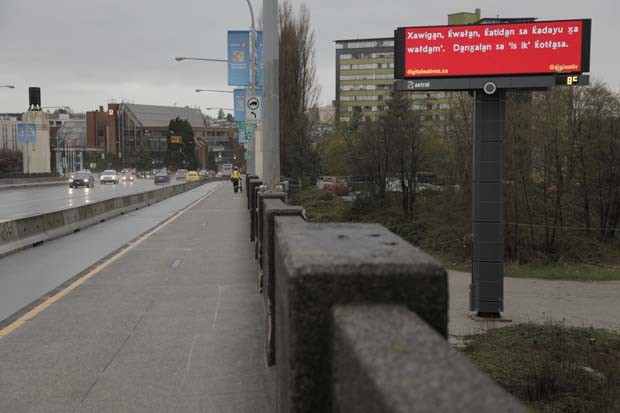Decoding 'Digital Natives'

On April 6, 2011, about three years before the City of Vancouver formally acknowledged that Vancouver is on unceded Coast Salish territory, the City declared its 125th birthday, celebrating with a series of free events and public art works. One public art project the City commissioned was Digital Natives, a text-based, site-specific installation considering Indigeneity in the early 21st century of globalised digital communication technologies and media saturation. Curated by poet Clint Burnham and artist Lorna Brown for Other Sights for Artists’ Projects, the installation took the form of a series of tweet-like texts broadcast on Astral Media’s large electric billboard, located on Sen’akw, Squamish Nation territory, just to the side of the Burrard Street Bridge. From April 4 –30, pedestrians, cyclists, and drivers encountered typical billboard content, advertisements, interspersed with unattributed texts by several Indigenous and non-Indigenous North American artists and writers, including several Vancouver poets.
Brown’s catalogue essay “Mixing Messages” considers the production of meaning in public spaces. She says readers are sophisticated at decoding the signage they encounter on daily basis in the city: information/instruction on how to move through the polis as a docile body, monuments to the colonial enterprise, and ever ubiquitous advertising. The use of the billboard for the project is a deliberate attempt to disrupt everyday reading practices within the realm of consumption. Careful to qualify to term because of its violent connotations, Brown says “intervention […] is the correct word to describe the introduction of texts by individual people under the guise of art, into this field of operations. Using the sign itself as an artistic/literary space for exchange between native and non-native contributors and communities, Digital Natives places the banality of advertising language next to its tactical use in the process of colonization, and alongside the word and image craft of contemporary poetics and art.”
While the process of meaning making for readers of Digital Natives is more complex than translating advertising, some texts use the familiar conventions of social media, making messages more easily decipherable:
If you lived under this bridge
you’d be home by now
#gentrification

A détournement of “If you lived here you’d already be home”, a slogan for one of Vancouver real-estate developer Bob Rennie’s many projects, this message calls attention to homelessness, linking it with gentrification.
Some interventions make interpretation more challenging such as Marianne Nicolson’s, of the Kwakwaka’wakw Nations, who wrote:
Dukwala’masixwa ’Kikw?
Can you see the Totem Pole?

Nicolson’s message, in Kwak’wala and English, places Indigenous language first, positioning English as secondary, creating a pause in citizens’ typical visual engagement with the city’s signage through her deployment of a native yet “foreign” language. Having read the second line in English, viewers now understand the meaning of the first line, then pause yet again to comprehend the question she asks. Her text also points out the City's strategic use of totem poles in the past. Brown’s essay includes an email from the contributor, who says her text refers to both medium of the billboard and a nearby totem pole:
Celebrating the centennial of BC in 1958, the Kwakwaka’wakw artist, Mungo Martin carved a gift pole for Queen Elizabeth. This pole was shipped to England (along with Mungo Martin) as an official present. A copy of this pole was erected near the Maritime Museum and the Vancouver Museum just below the Burrard Bridge and adjacent to the contested billboard site. The reference is a play with the formal character of the digital billboard erected atop its tall pole. The act of public advertisement mimics the Pacific Coast Aboriginal public declaration of rank and ownership traditionally expressed by the ‘totem pole’. The concepts segue with contemporary land disputes over land ownership and voice (who has a right to say what, where and how) and the idea of cultural ownership and spectacle (to see).
Translations of English texts into Kwak'wala, Skwxwú7mesh/Squamish and Hen’q’emin’em’/Musqueam are simply unreadable for most viewers, while some interventions are overtly legible in all-caps English, such as Indigenous American artist Edgar Heap of Bird’s:
IMPERIAL CANADA AWARDED SEX ABUSE TO NATIVE
YOUTH BY THE BLACK ROBES NOW PROUDLY BESTOWS
BRONZE SILVER GOLD MEDALS WITH INDIAN IMAGE

This text, censored by Astral Media, situates the Vancouver 2010 Winter Olympics’ commodification of Indigenous culture within the historical context of Canada’s residential school system that attempted, with some success, to destroy the native population of Canada. This system separated families, forcing children in live in residential schools where they had to wear Western clothes and hairstyles, and practice Western religion; they were forbidden to speak their native languages and lacked adequate food, shelter and medical care. Children experienced unchecked physical and sexual abuse by the Church officials and staff that operated the schools.
To “show the world” that the government honours First Nations culture, new road signage including the Indigenous names of places popped up along the newly-expanded Sea to Sky highway shortly before the spectacle of the Olympics began; these physical and semiotic signs position English names over Salish names, representing the imposition of the state on the original people of the land. The road signs may have raised awareness of native names, but they do little address systemic racism against Indigenous people, and the Games, a powerful agent of gentrification wherever they go, increased the numbers of homeless Indigenous people, some of whom may be sheltering at the ongoing tent city protest against homelesness at Oppenheimer Park.
Another message plainly states to the public what Indigenous people require for present and future economic security:
economic stability = capital transfer /
access to natural resources / forestry tenure /
fish allocations / water reservations

And this intervention tells non-Indigenous Canadians what they need to recognize in concrete ways:
It’s all unceded land is it not?

Unceded west coast city: Vancouver